Nature-Based Solutions in Urban Green Infrastructure: A Systematic Review of Success Factors and Implementation Challenges
Abstract
1. Introduction
2. Methodology
3. Results and Discussions
3.1. Geographical Distribution of Research on NBSs in Urban Green Infrastructure
3.2. How Do Various Analytical Approaches and Methodologies Contribute to the Assessment of NBSs in Urban Green Infrastructure?
3.3. What Are the Key NBSs That Have Been Used to Develop Urban Green Infrastructure?
3.4. Which Factors Contribute to the Successful Implementation of NBSs in Developing Urban Green Infrastructure?
3.4.1. The Perspective of Spatial Justice in the Implementation of NBS Projects
- Integration and Adaptability of NBS Projects with Urban Attributes
- The Role of Spatial Justice in Implementing NBSs in Urban Spaces
3.4.2. Enhancing and Ecosystem Management
- Restoring Biodiversity and Ecosystem Services
3.4.3. Integrated Governance Strategies
- Developing Supportive Policies
- Institutional and Structural Challenges in the Implementation of the NBS Project
3.4.4. Financial Resources and Economic Benefits
- Financial Resources and Financial Services for NBS Projects
- Economic Benefits and Human Resource Management
3.4.5. Technical Knowledge and Expertise
- Technical Expertise and Environmental Knowledge in Implementing NBS Projects
- Adaptive Planning and Collaborative Strategies in NBS Projects
3.4.6. Optimizing Stakeholder Engagement in NBS Implementation
- Engaging Stakeholders in NBS Project Development
3.5. What Are the Key Barriers That Hinder the Implementation of NBSs in Urban Green Infrastructure?
3.5.1. Physical–Spatial
- Competing Claims on Urban Land
3.5.2. Economic
- Challenges in Attracting Investment for NBS Implementation
3.5.3. Technical
- Lack of Standardized Information and Resources
3.5.4. Social
- Challenges in Public Perception and Social Acceptance of NBS
3.5.5. Political
- Political and Governance Challenges
- Regulatory and Legal Barriers to NBS Implementation
3.6. What Roles Do Stakeholders Play in Planning and Delivering NBSs in Urban Green Infrastructure?
3.6.1. Local Governments
- Policy-Making and Regulatory Frameworks
- Collaboration and Local-Level Education
3.6.2. Private Sector Actors
- Sustainable Innovation and Green Investment
3.6.3. Communities
- Sustainable Management and Social Participation
4. Conclusions
Author Contributions
Funding
Data Availability Statement
Acknowledgments
Conflicts of Interest
References
- Dong, X.; Yang, R.; Ye, Y.; Yi, S.; Haase, D.; Lausch, A. Planning for green infrastructure by integrating multi-driver: Ranking priority based on accessibility equity. Sustain. Cities Soc. 2024, 114, 105767. [Google Scholar] [CrossRef]
- Zhang, H.; Zhou, Q.; Yang, J.; Xiang, H. Change and driving factors of eco-environmental quality in Beijing green belts: From the perspective of Nature-based Solutions. Ecol. Indic. 2024, 166, 112581. [Google Scholar] [CrossRef]
- Sultana, R.; Birtchnell, T.; Gill, N. Grassroots Innovation for Urban Greening within a Governance Vacuum by Slum Dwellers in Dhaka. Sustainability 2022, 14, 11631. [Google Scholar] [CrossRef]
- Nardella, L.; Sebastiani, A.; Stafoggia, M.; Buonocore, E.; Paolo Franzese, P.; Manes, F. Modeling regulating ecosystem services along the urban–rural gradient: A comprehensive analysis in seven Italian coastal cities. Ecol. Indic. 2024, 165, 112161. [Google Scholar] [CrossRef]
- Krull, W.; Berry, P.; Bauduceau, N.; Elmqvist, T.; Fernandez, M.; Hartig, T.; Mayerhofer, E.; Naumann, S.; Noring, L.; Raskin, K.; et al. Towards an EU Research and Innovation Policy Agenda for Nature-Based Solutions & Re-Naturing Cities. Final Report of the Horizon 2020 Expert Group on ‘Nature-Based Solutions and Re-Naturing Cities’; European Commission: Brussels, Belgium, 2015. [Google Scholar]
- Scott, M.; Lennon, M.; Haase, D.; Kazmierczak, A.; Clabby, G.; Beatley, T. Nature-based solutions for the contemporary city/Re-naturing the city/Reflections on urban landscapes, ecosystems services and nature-based solutions in cities/Multifunctional green infrastructure and climate change adaptation: Brownfield greening as an adaptation strategy for vulnerable communities?/Delivering green infrastructure through planning: Insights from practice in Fingal, Ireland/Planning for biophilic cities: From theory to practice. Plan. Theory Pract. 2016, 17, 267–300. [Google Scholar] [CrossRef]
- Kullmann, K. Green-Networks: Integrating Alternative Circulation Systems into Post-industrial Cities. J. Urban Des. 2013, 18, 36–58. [Google Scholar] [CrossRef]
- Mazza, L.; Bennett, G.; De Nocker, L.; Gantioler, S.; Losarcos, L.; Margerison, C.; Kaphengst, T.; McConville, A.; Rayment, M.; ten Brink, P.; et al. Green Infrastructure Implementation and Efficiency; Institute for European Environmental Policy: London, UK, 2011. [Google Scholar]
- Benedict, M.; MacMahon, E. Green Infrastructure: Smart Conservation for the 21st Century. Renew. Resour. J. 2002, 20, 12–17. [Google Scholar]
- Lyu, L.; Sho, K.; Zhao, H.; Song, Y.; Uchiyama, Y.; Kim, J.; Sakai, T. Construction, assessment, and protection of green infrastructure networks from a dynamic perspective: A case study of Dalian City, Liaoning Province, China. Urban For. Urban Greening 2024, 101, 128545. [Google Scholar] [CrossRef]
- Croeser, T.; Bekessy, S.A.; Garrard, G.E.; Kirk, H. Nature-based solutions for urban biodiversity: Spatial targeting of retrofits can multiply ecological connectivity benefits. Landsc. Urban Plan. 2024, 251, 105169. [Google Scholar] [CrossRef]
- Shahab, S. Transaction Costs in Planning Literature: A Systematic Review. J. Plan. Lit. 2021, 37, 403–414. [Google Scholar] [CrossRef]
- Herreros-Cantis, P.; Hoffman, L.; Kennedy, C.; Kim, Y.; Charles, J.; Gillet, V.; Getzin, A.; Littlefield, D.; Zielinski, A.; Bernstein, J.; et al. Co-producing research and data visualization for environmental justice advocacy in climate change adaptation: The Milwaukee Flood-Health Vulnerability Assessment. Cities 2024, 155, 105474. [Google Scholar] [CrossRef]
- Atri, M.; Nedae-Tousi, S.; Shahab, S.; Solgi, E. The Effects of Thermal-Spatial Behaviours of Land Covers on Urban Heat Islands in Semi-Arid Climates. Sustainability 2021, 13, 13824. [Google Scholar] [CrossRef]
- Grunwald, A. Diverging pathways to overcoming the environmental crisis: A critique of eco-modernism from a technology assessment perspective. J. Clean. Prod. 2018, 197, 1854–1862. [Google Scholar] [CrossRef]
- Morpurgo, J.; Remme, R.P.; Van Bodegom, P.M. CUGIC: The Consolidated Urban Green Infrastructure Classification for assessing ecosystem services and biodiversity. Landsc. Urban Plann. 2023, 234, 104726. [Google Scholar] [CrossRef]
- Bastian, O.; Haase, D.; Grunewald, K. Ecosystem properties, potentials and services-The EPPS conceptual framework and an urban application example. Ecol. Indic. 2012, 21, 7–16. [Google Scholar] [CrossRef]
- Sturiale, L.; Scuderi, A.; Timpanaro, G. Citizens’ perception of the role of urban nature-based solutions and green infrastructures towards climate change in Italy. Front. Environ. Sci. 2023, 11, 1105446. [Google Scholar] [CrossRef]
- Faivre, N.; Fritz, M.; Freitas, T.; de Boissezon, B.; Vandewoestijne, S. Nature-Based Solutions in the EU: Innovating with nature to address social, economic and environmental challenges. Environ. Res. 2017, 159, 509–518. [Google Scholar] [CrossRef]
- Dick, J.; Miller, J.D.; Carruthers-Jones, J.; Dobel, A.J.; Carver, S.; Garbutt, A.; Hester, A.; Hails, R.; Magreehan, V.; Quinn, M. How are nature based solutions contributing to priority societal challenges surrounding human well-being in the United Kingdom: A systematic map protocol. Environ. Evid. 2019, 8, 37. [Google Scholar] [CrossRef]
- Marino, R.; Kuller, M.; Zurita, B.; Carrasco, L.; Gosciniak, P.; Kustosik, K.; Riveros, A. Assessment of public space potential for climate change adaptation in three Colombian cities: Nature-based solutions and urban design guidelines. Water Pract. Technol. 2024, 19, 1696–1709. [Google Scholar] [CrossRef]
- Lafortezza, R.; Sanesi, G. Nature-based solutions: Settling the issue of sustainable urbanization. Environ. Res. 2019, 172, 394–398. [Google Scholar] [CrossRef]
- Liu, H.; Jay, M.; Chen, X. The role of nature-based solutions for improving environmental quality, health and well-being. Sustainability 2021, 13, 10950. [Google Scholar] [CrossRef]
- Štrbac, S.; Kašanin-Grubin, M.; Pezo, L.; Stojić, N.; Lončar, B.; Ćurčić, L.; Pucarević, M. Green Infrastructure Designed through Nature-Based Solutions for Sustainable Urban Development. Int. J. Environ. Res. Public Health 2023, 20, 1102. [Google Scholar] [CrossRef] [PubMed]
- Diep, L.; Mulligan, J.; Oloo, M.A.; Guthmann, L.; Raido, M.; Ndezi, T. Co-building trust in urban nature: Learning from participatory design and construction of Nature-Based Solutions in informal settlements in East Africa. Front. Sustain. Cities. 2022, 4, 927723. [Google Scholar] [CrossRef]
- Tiwary, A.; Vilhar, U.; Zhiyanski, M.; Stojanovski, V.; Dinca, L. Management of nature-based goods and services provisioning from the urban common: A pan-European perspective. Urban Ecosyst. 2020, 23, 645–657. [Google Scholar] [CrossRef]
- Sommese, F. Nature-Based Solutions to Enhance Urban Resilience in the Climate Change and Post-Pandemic Era: A Taxonomy for the Built Environment. Buildings 2024, 14, 2190. [Google Scholar] [CrossRef]
- Mosler, S.; Hobson, P. Close-to-nature heuristic design principles for future urban green infrastructure. Urban Plan. 2021, 6, 67–79. [Google Scholar] [CrossRef]
- Adams, C.; Frantzeskaki, N.; Moglia, M. Actors mainstreaming nature-based solutions in cities: A case study of Melbourne’s change agents and pathways for urban sustainability transformations. Environ. Sci. Policy 2024, 155, 103723. [Google Scholar] [CrossRef]
- Lechner, A.M.; Gomes, R.L.; Rodrigues, L.; Ashfold, M.J.; Selvam, S.B.; Wong, E.P.; Raymond, C.M.; Zieritz, A.; Sing, K.W.; Moug, P.; et al. Challenges and considerations of applying nature-based solutions in low- And middle-income countries in Southeast and East Asia. BG. Syst. 2020, 2, 331–351. [Google Scholar] [CrossRef]
- Donthu, N.; Kumar, S.; Mukherjee, D.; Pandey, N.; Lim, W.M. How to conduct a bibliometric analysis: An overview and guidelines. J. Bus. Res. 2021, 133, 285–296. [Google Scholar] [CrossRef]
- Bengtsson, M. How to plan and perform a qualitative study using content analysis. NursingPlus Open 2016, 2, 8–14. [Google Scholar] [CrossRef]
- Allan, A.; Soltani, A.; Abdi, M.H.; Zarei, M. Driving Forces behind Land Use and Land Cover Change: A Systematic and Bibliometric Review. Land 2022, 11, 1222. [Google Scholar] [CrossRef]
- Öztürk, O.; Kocaman, R.; Kanbach, D.K. How to design bibliometric research: An overview and a framework proposal. Rev. Manag. Sci. 2024, 18, 3333–3361. [Google Scholar] [CrossRef]
- Kleinheksel, A.J.; Rockich-Winston, N.; Tawfik, H.; Wyatt, T.R. Demystifying Content Analysis. Am. J. Pharm. Educ. 2020, 84, 7113. [Google Scholar] [CrossRef] [PubMed]
- Oleinik, A.; Popova, I.; Kirdina, S.; Shatalova, T. On the choice of measures of reliability and validity in the content-analysis of texts. Qual. Quant. 2014, 48, 2703–2718. [Google Scholar] [CrossRef]
- Aghaei Chadegani, A.; Salehi, H.; Yunus, M.; Farhadi, H.; Fooladi, M.; Farhadi, M.; Ale Ebrahim, N. A Comparison between Two Main Academic Literature Collections: Web of Science and Scopus Databases. Asian Soc. Sci. 2024, 9, 18. [Google Scholar] [CrossRef]
- Dadashpoor, H.; Malekzadeh, N. Driving factors of formation, development, and change of spatial structure in metropolitan areas: A systematic review. J. Urban Manag. 2020, 9, 286–297. [Google Scholar] [CrossRef]
- Zarei, M.; Arasteh, M.; Shahab, S. Exploring Port–City Relationships: A Bibliometric and Content Analysis. Sustainability 2024, 16, 4341. [Google Scholar] [CrossRef]
- Alves, A.; van Opstal, C.; Keijzer, N.; Sutton, N.; Chen, W.S. Planning the multifunctionality of nature-based solutions in urban spaces. Cities 2024, 146, 104751. [Google Scholar] [CrossRef]
- Rizzo, A.; Conte, G.; Masi, F. Adjusted unit value transfer as a tool for raising awareness on ecosystem services provided by constructed wetlands for water pollution control: An italian case study. Int. J. Environ. Res. Public Health 2021, 18, 1531. [Google Scholar] [CrossRef]
- Espinal-Giron, A.; Benegas Negri, L.; Brenes, C.; Birkel, C.; Prins, C. Assessing Potential Effects of Nature-Based Solutions (NBS) on Water Ecosystem Service in the Interurban Micro-Watershed Río Torres, Costa Rica. Forests 2023, 14, 937. [Google Scholar] [CrossRef]
- Ferreira, M.J.; da Rocha, H.R. Green roof infrastructure outperforms grey technology in flood mitigation in São Paulo’s urbanized region. Front. Built Environ. 2023, 9, 1254942. [Google Scholar] [CrossRef]
- Pumo, D.; Alongi, F.; Cannarozzo, M.; Noto, L.V. Climate adaptive urban measures in Mediterranean areas: Thermal effectiveness of an advanced multilayer green roof installed in Palermo (Italy). Build. Environ. 2023, 243, 110731. [Google Scholar] [CrossRef]
- Brom, P.; Engemann, K.; Breed, C.; Pasgaard, M.; Onaolapo, T.; Svenning, J.C. A Decision Support Tool for Green Infrastructure Planning in the Face of Rapid Urbanization. Land 2023, 12, 415. [Google Scholar] [CrossRef]
- Cárdenas, M.L.; Wilde, V.; Hagen-Zanker, A.; Seifert-Dähnn, I.; Hutchins, M.G.; Loiselle, S. The circular benefits of participation in nature-based solutions. Sustainability 2021, 13, 4344. [Google Scholar] [CrossRef]
- van Oorschot, J.; Sprecher, B.; van ‘t Zelfde, M.; van Bodegom, P.M.; van Oudenhoven, A.P.E. Assessing urban ecosystem services in support of spatial planning in the Hague, the Netherlands. Landsc. Urban Plann. 2021, 214, 104195. [Google Scholar] [CrossRef]
- Lai, S.; Leone, F.; Zoppi, C. Assessment of municipal masterplans aimed at identifying and fostering green infrastructure: A study concerning three towns of the metropolitan area of Cagliari, Italy. Sustainability 2019, 11, 1470. [Google Scholar] [CrossRef]
- López-Maciel, M.; Roebeling, P.; Llewellyn, R.; Figueiredo, E.; Matos, F.A.; Mendonça, R.; Bastos, M.I.; Mendes, R.; Postmes, L.; Van Dinter, M. Adoption and Diffusion of Nature-Based Solutions by Property Owners in Urban Areas: The Case of Green Roofs in Eindhoven, The Netherlands. Resources 2023, 12, 133. [Google Scholar] [CrossRef]
- Savić, S.; Krstić, H.; Šećerov, I.; Dunjić, J. Decreasing the energy demand in public buildings using nature-based solutions: Case studies from Novi Sad (Republic of Serbia) and Osijek (Republic of Croatia). Energy Sustain. Soc. 2024, 14, 23. [Google Scholar] [CrossRef]
- Reu Junqueira, J.; Serrao-Neumann, S.; White, I. Developing and testing a cost-effectiveness analysis to prioritize green infrastructure alternatives for climate change adaptation. Water Environ. J. 2023, 37, 242–255. [Google Scholar] [CrossRef]
- Shrestha, S.; Cui, S.; Xu, L.; Wang, L.; Manandhar, B.; Ding, S. Impact of land use change due to urbanisation on surface runoff using GIS-based SCS–CN method: A case study of Xiamen city, China. Land 2021, 10, 839. [Google Scholar] [CrossRef]
- Szopińska-Mularz, M.; Lehmann, S. Balancing Increased Urban Density with Green Spaces: The Marketing of New Housing Estates in Poland. Buildings 2023, 13, 777. [Google Scholar] [CrossRef]
- Rice, L. Nature-based solutions for urban development and tourism. Int. J. Tour. Cities 2020, 6, 431–448. [Google Scholar] [CrossRef]
- Zuniga-Teran, A.A.; Staddon, C.; de Vito, L.; Gerlak, A.K.; Ward, S.; Schoeman, Y.; Hart, A.; Booth, G. Challenges of mainstreaming green infrastructure in built environment professions. J. Environ. Plann. Manag. 2020, 63, 710–732. [Google Scholar] [CrossRef]
- Neumann, V.A.; Hack, J. A methodology of policy assessment at the municipal level: Costa Rica’s readiness for the implementation of nature-based-solutions for urban stormwater management. Sustainability 2020, 12, 230. [Google Scholar] [CrossRef]
- Pancewicz, A.; Bednarz, D.; Drożdż, D.; Marszoł, M.; Suchy, N. The Use of Nature-Based Solutions in the Adaptation of Large Polish Cities to Climate Change and Energy Transformation: A Comparative Analysis. Energies 2023, 16, 5189. [Google Scholar] [CrossRef]
- Dorst, H.; van der Jagt, A.; Toxopeus, H.; Tozer, L.; Raven, R.; Runhaar, H. What’s behind the barriers? Uncovering structural conditions working against urban nature-based solutions. Landsc. Urban Plan. 2022, 220, 104335. [Google Scholar] [CrossRef]
- Cui, M.; Ferreira, F.; Fung, T.K.; Matos, J.S. Tale of two cities: How nature-based solutions help create adaptive and resilient urban water management practices in singapore and lisbon. Sustainability 2021, 13, 10427. [Google Scholar] [CrossRef]
- Mejía, C.V.; Shirotova, L.; De Almeida, I.F.M. Green infrastructure and German landscape planning: A comparison of approaches. Urbani Izziv 2015, 26, S25–S37. [Google Scholar] [CrossRef]
- Ibric, A.; Bostenaru Dan, M.; Crăciun, C. Adapting Street Profile Design by Using Nature-Based Solutions in New Neighbourhoods and the Retrofit of Buildings. Buildings 2024, 14, 1920. [Google Scholar] [CrossRef]
- Muwafu, S.P.; Rölfer, L.; Scheffran, J.; Costa, M.M. A framework for assessing social structure in community governance of sustainable urban drainage systems: Insights from a literature review. Mitig. Adapt. Strateg. Glob. Change 2024, 29, 42. [Google Scholar] [CrossRef]
- Lemes de Oliveira, F.; Mare’e, S.; Khattab, R.; Alqatamin, H.; Younis, A.; Crinion, K.; Zhong, H.; Kaddour, I.Z.; Sharmin, T. Conceptualising nature-based solutions: Addressing environmental challenges in the city of Amman, Jordan. Urban Res. Pract. 2024, 18, 6–18. [Google Scholar] [CrossRef]
- Perrotti, D.; Stremke, S. Can urban metabolism models advance green infrastructure planning? Insights from ecosystem services research. Environ. Plann. 2020, 47, 678–694. [Google Scholar] [CrossRef]
- Adams, C.; Frantzeskaki, N.; Moglia, M. Mainstreaming nature-based solutions in cities: A systematic literature review and a proposal for facilitating urban transitions. Land Use Policy 2023, 130, 106661. [Google Scholar] [CrossRef]
- Camerin, F.; Longato, D. Designing healthier cities to improve life quality: Unveiling challenges and outcomes in two Spanish cases. J. Urban Des. 2024, 30, 1–30. [Google Scholar] [CrossRef]
- Mell, I.; Clement, S.; O’Sullivan, F. Mainstreaming Nature-Based Solutions in City Planning: Examining Scale, Focus, and Visibility as Drivers of Intervention Success in Liverpool, UK. Land 2023, 12, 1371. [Google Scholar] [CrossRef]
- Buffam, I.; Hagemann, F.A.; Emilsson, T.; Gamstetter, D.; Pálsdóttir, A.M.; Randrup, T.B.; Yeshitela, K.; Ode Sang, Å. Priorities and barriers for urban ecosystem service provision: A comparison of stakeholder perspectives from three cities. Front. Sustain. Cities 2022, 4, 838971. [Google Scholar] [CrossRef]
- Brokking, P.; Mörtberg, U.; Balfors, B. Municipal practices for integrated planning of nature-based solutions in urban development in the stockholm region. Sustainability 2021, 13, 10389. [Google Scholar] [CrossRef]
- Vaňo, S.; Stahl Olafsson, A.; Mederly, P. Advancing urban green infrastructure through participatory integrated planning: A case from Slovakia. Urban For. Urban Green. 2021, 58, 126957. [Google Scholar] [CrossRef]
- O’Sullivan, F.; Mell, I.; Clement, S. Novel Solutions or Rebranded Approaches: Evaluating the Use of Nature-Based Solutions (NBS) in Europe. Front. Sustain. Cities 2020, 2, 572527. [Google Scholar] [CrossRef]
- Dushkova, D.; Haase, D. Not simply green: Nature-based solutions as a concept and practical approach for sustainability studies and planning agendas in cities. Land 2020, 9, 19. [Google Scholar] [CrossRef]
- Song, J.; Hemingway, J.; Park, C.S. Perspective Swap from Central Europe to East Asia: How Relevant Is Urban Environmental Acupuncture in Small-Scale Green Space Development in the Context of the Republic of Korea? Land 2024, 13, 298. [Google Scholar] [CrossRef]
- Moosavi, S.; Browne, G.R.; Bush, J. Perceptions of nature-based solutions for Urban Water challenges: Insights from Australian researchers and practitioners. Urban For. Urban Green. 2021, 57, 126937. [Google Scholar] [CrossRef]
- Yazar, M.; Baykal Fide, E.; Daloglu Cetinkaya, I. The nested hierarchy of urban vulnerability within land use policies fails to address climate injustices in Turkey. J. Environ. Policy Plann. 2024, 26, 30–46. [Google Scholar] [CrossRef]
- Matter, N.M.; Gado, N.G. Constructed wetlands nature-based solutions to enhance urban resilience in Egyptian cities. HBRC J. 2024, 20, 231–255. [Google Scholar] [CrossRef]
- Hoover, F.A.; Meerow, S.; Coleman, E.; Grabowski, Z.; McPhearson, T. Why go green? Comparing rationales and planning criteria for green infrastructure in U.S. city plans. Landsc. Urban Plann. 2023, 237, 104781. [Google Scholar] [CrossRef]
- Bona, S.; Silva-Afonso, A.; Gomes, R.; Matos, R.; Rodrigues, F. Nature-Based Solutions in Urban Areas: A European Analysis. Appl. Sci. 2023, 13, 168. [Google Scholar] [CrossRef]
- Zain, A.F.M.; Pribadi, D.O.; Indraprahasta, G.S. Revisiting the Green City Concept in the Tropical and Global South Cities Context: The Case of Indonesia. Front. Environ. Sci. 2022, 10, 787204. [Google Scholar] [CrossRef]
- Hamel, P.; Hamann, M.; Kuiper, J.J.; Andersson, E.; Arkema, K.K.; Silver, J.M.; Daily, G.C.; Guerry, A.D. Blending Ecosystem Service and Resilience Perspectives in Planning of Natural Infrastructure: Lessons from the San Francisco Bay Area. Front. Environ. Sci. 2021, 9, 601136. [Google Scholar] [CrossRef]
- Shi, L. Beyond flood risk reduction: How can green infrastructure advance both social justice and regional impact? Socio-Ecol. Pract. Res. 2020, 2, 311–320. [Google Scholar] [CrossRef]
- Zwierzchowska, I.; Fagiewicz, K.; Poniży, L.; Lupa, P.; Mizgajski, A. Introducing nature-based solutions into urban policy-facts and gaps. Case study of Poznań. Land Use Policy 2019, 85, 161–175. [Google Scholar] [CrossRef]
- Raymond, C.M.; Frantzeskaki, N.; Kabisch, N.; Berry, P.; Breil, M.; Nita, M.R.; Geneletti, D.; Calfapietra, C. A framework for assessing and implementing the co-benefits of nature-based solutions in urban areas. Environ. Sci. Policy 2017, 77, 15–24. [Google Scholar] [CrossRef]
- Wendling, L.A.; Huovila, A.; zu Castell-Rüdenhausen, M.; Hukkalainen, M.; Airaksinen, M. Benchmarking nature-based solution and smart city assessment schemes against the sustainable development goal indicator framework. Front. Environ. Sci. 2018, 6, 69. [Google Scholar] [CrossRef]
- Reeve, A.C.; Desha, C.; Hargreaves, D.; Hargroves, K. Biophilic urbanism: Contributions to holistic urban greening for urban renewal. Smart Sustain. Built Environ. 2015, 4, 215–233. [Google Scholar] [CrossRef]
- Latasa, I.; Laurenz, A.; Sádaba, J. Urban green infrastructure as a strategy to address urban energy efficiency and sustainability. A case study of milagrosa (pamplona). Sustainability 2022, 14, 28. [Google Scholar] [CrossRef]
- Curran, W.; Hamilton, T. Nature-based solutions in hiding: Goslings and greening in the still-industrial city. Socio-Ecol. Pract. Res 2020, 2, 321–327. [Google Scholar] [CrossRef]
- Blau, M.L.; Luz, F.; Panagopoulos, T. Urban river recovery inspired by nature-based solutions and biophilic design in Albufeira, Portugal. Land 2018, 7, 141. [Google Scholar] [CrossRef]
- Capotorti, G.; Mollo, B.; Zavattero, L.; Anzellotti, I.; Celesti-Grapow, L. Setting priorities for urban forest planning. A comprehensive response to ecological and social needs for the metropolitan area of Rome (Italy). Sustainability 2015, 7, 3958–3976. [Google Scholar] [CrossRef]
- Zulian, G.; Polce, C.; Maes, J. ESTIMAP: A GIS-based model to map ecosystem services in the European Union. Ann. Bot. 2014, 4, 1–7. [Google Scholar] [CrossRef]
- Pérez, G.; Reyes, M.; Coma, J.; Alva, A.; Berigüete, F.E.; Lacasta, A.M. Methodological framework for impact evaluation of Building-Integrated Greenery (BIG-impact). MethodsX 2024, 13, 102961. [Google Scholar] [CrossRef]
- Olgun, R.; Cheng, C.; Coseo, P. Nature-Based Solutions Scenario Planning for Climate Change Adaptation in Arid and Semi-Arid Regions. Land 2024, 13, 1464. [Google Scholar] [CrossRef]
- Li, Y.B.; Wang, Q.C.; Chang, R. Nature-based solutions for fast-growing city regions: A new spatial equilibrium model for complementary urban green space planning. J. Clean. Prod. 2024, 462, 142671. [Google Scholar] [CrossRef]
- Van der Borght, R.; Pallares-Barbera, M. Greening to shield: The impacts of extreme rainfall on economic activity in Latin American cities. Glob. Environ. Change 2024, 87, 102857. [Google Scholar] [CrossRef]
- Hanna, E.; Felipe-Lucia, M.R.; Comín, F.A. Scenario Analysis of Green Infrastructure to Adapt Medium-Size Cities to Climate Change: The Case of Zaragoza, Spain. Land 2024, 13, 280. [Google Scholar] [CrossRef]
- Staccione, A.; Essenfelder, A.H.; Bagli, S.; Mysiak, J. Connected urban green spaces for pluvial flood risk reduction in the Metropolitan area of Milan. Sustainable Cities Soc. 2024, 104, 105288. [Google Scholar] [CrossRef]
- Meenar, M.; Rahman, M.S.; Russack, J.; Bauer, S.; Kapri, K. “The Urban Poor and Vulnerable Are Hit Hardest by the Heat”: A Heat Equity Lens to Understand Community Perceptions of Climate Change, Urban Heat Islands, and Green Infrastructure. Land 2023, 12, 2174. [Google Scholar] [CrossRef]
- Anderson, V.; Zgela, M.; Gough, W.A. Building Urban Resilience with Nature-Based Solutions: A Multi-Scale Case Study of the Atmospheric Cleansing Potential of Green Infrastructure in Southern Ontario, Canada. Sustainability 2023, 15, 14146. [Google Scholar] [CrossRef]
- Goličnik Marušić, B.; Dremel, M.; Ravnikar, Ž. A frame of understanding to better link nature-based solutions and urban planning. Environ. Sci. Policy 2023, 146, 47–56. [Google Scholar] [CrossRef]
- Biasin, A.; Masiero, M.; Amato, G.; Pettenella, D. Nature-Based Solutions Modeling and Cost-Benefit Analysis to Face Climate Change Risks in an Urban Area: The Case of Turin (Italy). Land 2023, 12, 280. [Google Scholar] [CrossRef]
- Teotónio, I.; Oliveira Cruz, C.; Matos Silva, C.; Lopes, R.F.R. Bridging CBA and MCA for evaluating green infrastructure: Proposal of a new evaluation model (MAGICA). Socio-Econ. Plann. Sci. 2023, 85, 101446. [Google Scholar] [CrossRef]
- Shih, W.Y. Socio-ecological inequality in heat: The role of green infrastructure in a subtropical city context. Landsc. Urban Plann. 2022, 226, 104506. [Google Scholar] [CrossRef]
- Salata, S.; Erdoğan, B.; Ayruş, B. Designing Urban Green Infrastructures Using Open-Source Data—An Example in Çiğli, Izmir (Turkey). Urban. Sci. 2022, 6, 42. [Google Scholar] [CrossRef]
- Lampinen, J.; García-Antúnez, O.; Olafsson, A.S.; Kavanagh, K.C.; Gulsrud, N.M.; Raymond, C.M. Envisioning carbon-smart and just urban green infrastructure. Urban For. Urban Green. 2022, 75, 127682. [Google Scholar] [CrossRef]
- Banzhaf, E.; Anderson, S.; Grandin, G.; Hardiman, R.; Jensen, A.; Jones, L.; Knopp, J.; Levin, G.; Russel, D.; Wu, W.; et al. Urban-Rural Dependencies and Opportunities to Design Nature-Based Solutions for Resilience in Europe and China. Land 2022, 11, 480. [Google Scholar] [CrossRef]
- Gantar, D.; Kozamernik, J.; Erjavec, I.Š.; Koblar, S. From Intention to Implementation of Vertical Green: The Case of Ljubljana. Sustainability 2022, 14, 3198. [Google Scholar] [CrossRef]
- Voskamp, I.M.; de Luca, C.; Polo-Ballinas, M.B.; Hulsman, H.; Brolsma, R. Nature-based solutions tools for planning urban climate adaptation: State of the art. Sustainability 2021, 13, 6381. [Google Scholar] [CrossRef]
- Rędzińska, K.; Piotrkowska, M. Urban Planning and Design for Building Neighborhood Resilience to Climate Change. Land 2020, 9, 387. [Google Scholar] [CrossRef]
- Langemeyer, J.; Wedgwood, D.; McPhearson, T.; Baró, F.; Madsen, A.L.; Barton, D.N. Creating urban green infrastructure where it is needed—A spatial ecosystem service-based decision analysis of green roofs in Barcelona. Sci. Total Environ. 2020, 707, 135487. [Google Scholar] [CrossRef]
- Shade, C.; Kremer, P. Article predicting land use changes in Philadelphia following green infrastructure policies. Land 2019, 8, 28. [Google Scholar] [CrossRef]
- Stürck, J.; Schulp, C.J.E.; Verburg, P.H. Spatio-temporal dynamics of regulating ecosystem services in Europe- The role of past and future land use change. Appl. Geogr. 2015, 63, 121–135. [Google Scholar] [CrossRef]
- Danilina, N.; Tsurenkova, K.; Berkovich, V. Evaluating urban green public spaces: The case study of Krasnodar region cities, Russia. Sustainability 2021, 13, 14059. [Google Scholar] [CrossRef]
- Essuman-Quainoo, B.; Jim, C.Y. Understanding the drivers of green roofs and green walls adoption in Global South cities: Analysis of Accra, Ghana. Urban For. Urban Green. 2023, 89, 128106. [Google Scholar] [CrossRef]
- Kwartnik-Pruc, A.; Droj, G. The Role of Allotments and Community Gardens and the Challenges Facing Their Development in Urban Environments—A Literature Review. Land 2023, 12, 325. [Google Scholar] [CrossRef]
- IUCN. The IUCN Programme 2013–2016; International Union for the Conservation of Nature: Gland, Switzerland, 2013. [Google Scholar]
- Moorish, W.R.; Brown, C.R. Infrastructure for the New Social Compact; Routledge: London, UK, 2008. [Google Scholar]
- Benedict, M.A.; McMahon, E.T. Green Infrastructure: Linking Landscapes and Communities; Island Press: Washington, DC, USA, 2012. [Google Scholar]
- Fainstein, S.S. The just city. Int. J. Urban Sci. 2014, 18, 1–18. [Google Scholar] [CrossRef]
- Ahmadpoor, N.; Shahab, S. Urban form: Realising the value of green space: A planners’ perspective on the COVID-19 pandemic. Town Plan. Rev. 2021, 92, 49–55. [Google Scholar] [CrossRef]
- Aram, F.; Shahab, S.; Solgi, E. Editorial: Impacts of urban green spaces on environmental perceptions and social life. Front. Environ. Sci. 2022, 10, 1050597. [Google Scholar] [CrossRef]
- Green Infrastructure; European Union Commission: Brussels, Belgium, 2017.
- Bruno, E.; Falco, E.; Shahab, S.; Geneletti, D. Integrating ecosystem services in transfer of development rights: A literature review. Land Use Policy 2023, 131, 106694. [Google Scholar] [CrossRef]
- Jerome, G.; Sinnett, D.; Burgess, S.; Calvert, T.; Mortlock, R. A framework for assessing the quality of green infrastructure in the built environment in the UK. Urban For. Urban Green. 2019, 40, 174–182. [Google Scholar] [CrossRef]
- Byahut, S.; Ghosh, S.; Masilela, C. Urban Transformation for Sustainable Growth and Smart Living: The Case of the Atlanta Beltline. In Smart Living for Smart Cities: Community Study, Ways and Means; Vinod Kumar, T.M., Ed.; Springer: Singapore, 2020; pp. 73–100. [Google Scholar]
- Ambrose-Oji, B.; Lawrence, A.; Stewart, A. Community based forest enterprises in Britain: Two organising typologies. For. Policy Econ. 2015, 58, 65–74. [Google Scholar] [CrossRef]
- Nolan, P. Twenty five years of creating the Mersey Forest. Environ. Law Rev. 2019, 21, 265–268. [Google Scholar] [CrossRef]
- Carter, J.; Labib, S.M.; Mell, I. Understanding and Assessing Climate Change Risk to Green Infrastructure: Experiences from Greater Manchester (UK). Land 2024, 13, 697. [Google Scholar] [CrossRef]
- Al-Kodmany, K. Chicago as a Placemaking Model. In Tall Buildings and the City: Improving the Understanding of Placemaking, Imageability, and Tourism; Al-Kodmany, K., Ed.; Springer: Singapore, 2020; pp. 407–441. [Google Scholar]
- Gabbianelli, A. Formal and formless in Madrid Río Park. J. Landsc. Archit. 2020, 15, 60–73. [Google Scholar] [CrossRef]
- Crupi, F. Urban Regeneration and Green and Blue Infrastructure: The Case of the “Acilia–Madonnetta” Urban and Metropolitan Centrality in the Municipality of Rome. Urban. Sci. 2022, 6, 56. [Google Scholar] [CrossRef]
- Cassarino, M.; Shahab, S.; Biscaya, S. Envisioning Happy Places for All: A Systematic Review of the Impact of Transformations in the Urban Environment on the Wellbeing of Vulnerable Groups. Sustainability 2021, 13, 8086. [Google Scholar] [CrossRef]
- Dellinger, F.; Romier, A.-C.; Saint-Onge, G. Biodiversity in the Day-to-Day Practice of the Landscape Architect. In Urban Biodiversity and Ecological Design for Sustainable Cities; Ito, K., Ed.; Springer: Tokyo, Japan, 2021; pp. 35–76. [Google Scholar]
- Back, P.; Collins, A.M. Negotiating the green obstacle course: Ranking priorities and problems for municipal green infrastructure implementation. Urban For. Urban Green. 2022, 67, 127436. [Google Scholar] [CrossRef]
- Antony, J.; Ghadge, A.; Ashby, S.A.; Cudney, E.A. Lean Six Sigma journey in a UK higher education institute: A case study. Int. J. Qual. Reliab. Manag. 2018, 35, 510–526. [Google Scholar] [CrossRef]
- Dickinson, J.; Bennett, E.; Marson, J. Challenges facing green space: Is statute the answer? J. Place Manag. Dev. 2019, 12, 121–138. [Google Scholar] [CrossRef]
- Ryu, C.; Kwon, Y. How Do Mega Projects Alter the City to Be More Sustainable? Spatial Changes Following the Seoul Cheonggyecheon Restoration Project in South Korea. Sustainability 2016, 8, 1178. [Google Scholar] [CrossRef]
- Newman, P. Green Urbanism and its Application to Singapore. Environ. Urban. ASIA 2010, 1, 149–170. [Google Scholar] [CrossRef]
- Jang, N.; Doyon, A. Equitable Implementation of Green Infrastructure: An Analysis of the City of Vancouver. Can. Plan. Policy 2023, 2023, 110–132. [Google Scholar] [CrossRef]
- O’Brien, P.; Pike, A. City Deals, Decentralisation and the Governance of Local Infrastructure Funding and Financing in the UK. Natl. Inst. Econ. Rev. 2015, 233, R14–R26. [Google Scholar] [CrossRef]
- Cureton, P. The history of the future of a new town: Milton Keynes, the ‘Forest City’. J. Landsc. Archit. 2023, 18, 84–99. [Google Scholar] [CrossRef]
- Moore, L.; Mell, I. Examining the role of business improvement districts (BIDs) as contemporary alternatives for Green Infrastructure funding in London, UK. Urban For. Urban Green. 2023, 83, 127904. [Google Scholar] [CrossRef]
- Doustaly, C. Participatory Budgeting and Progressive Cities: Are London and Paris Listening to Their Own Voices? In The Rise of Progressive Cities East and West; Douglass, M., Garbaye, R., Ho, K.C., Eds.; Springer: Singapore, 2019; pp. 117–136. [Google Scholar]
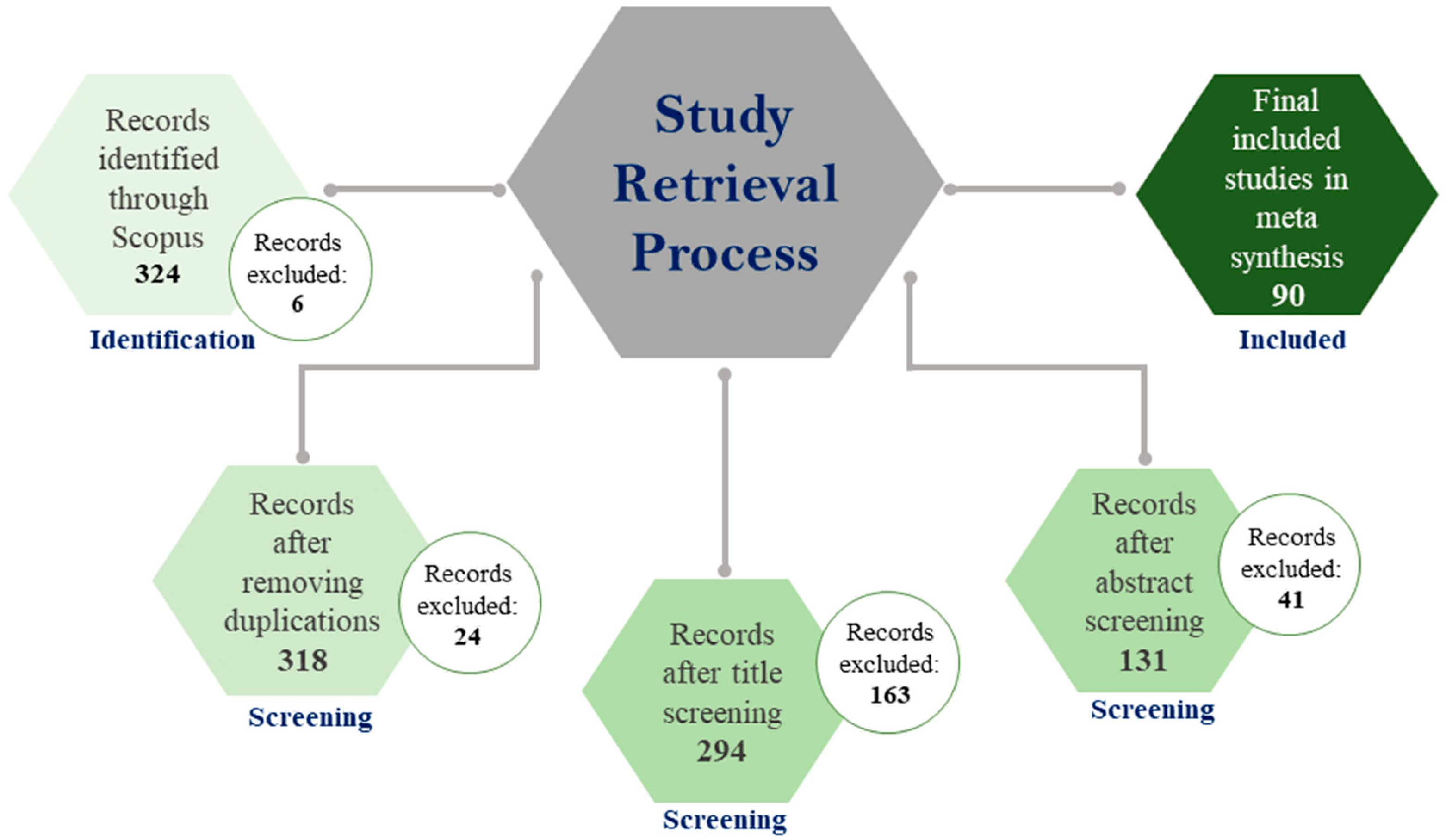
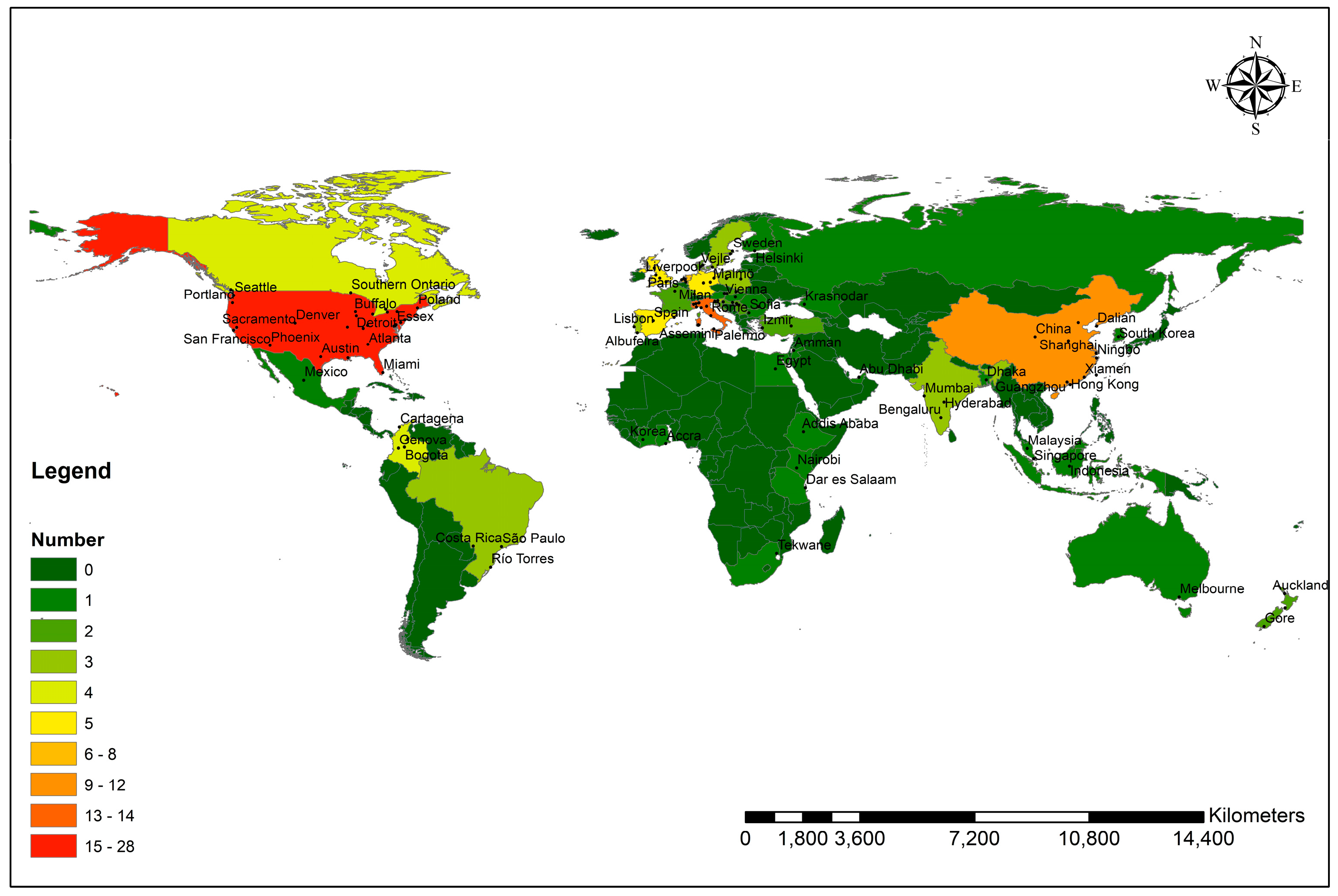
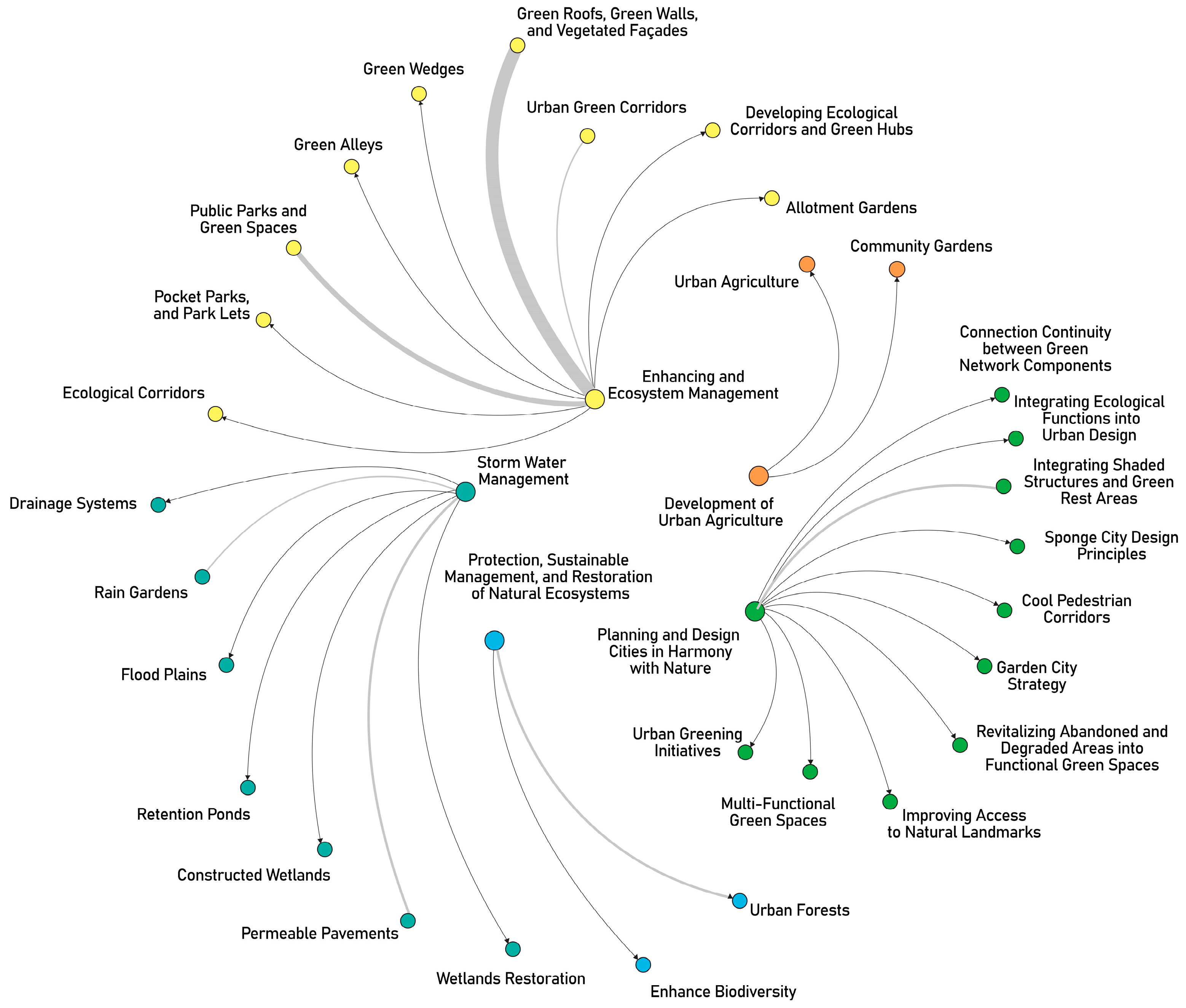
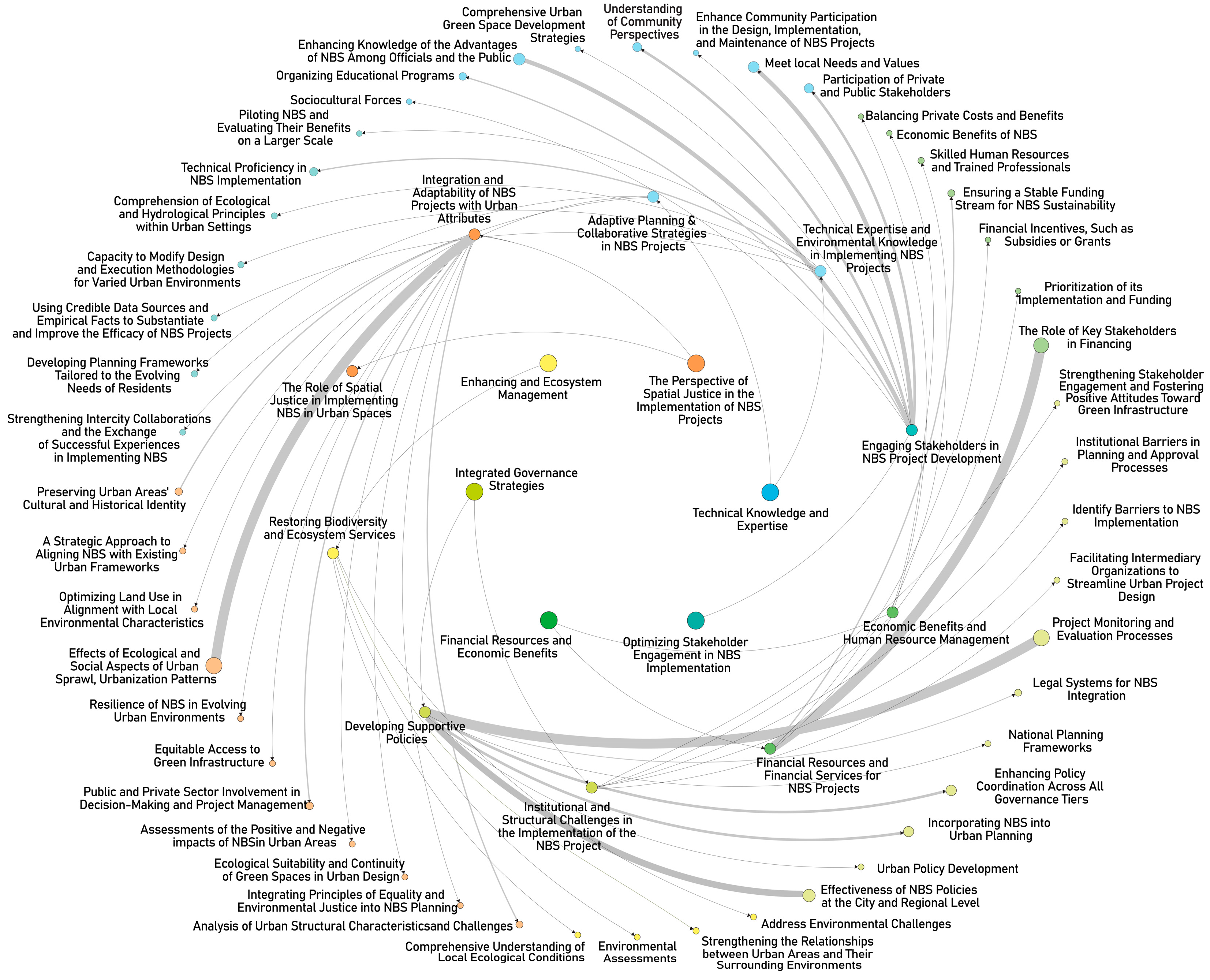
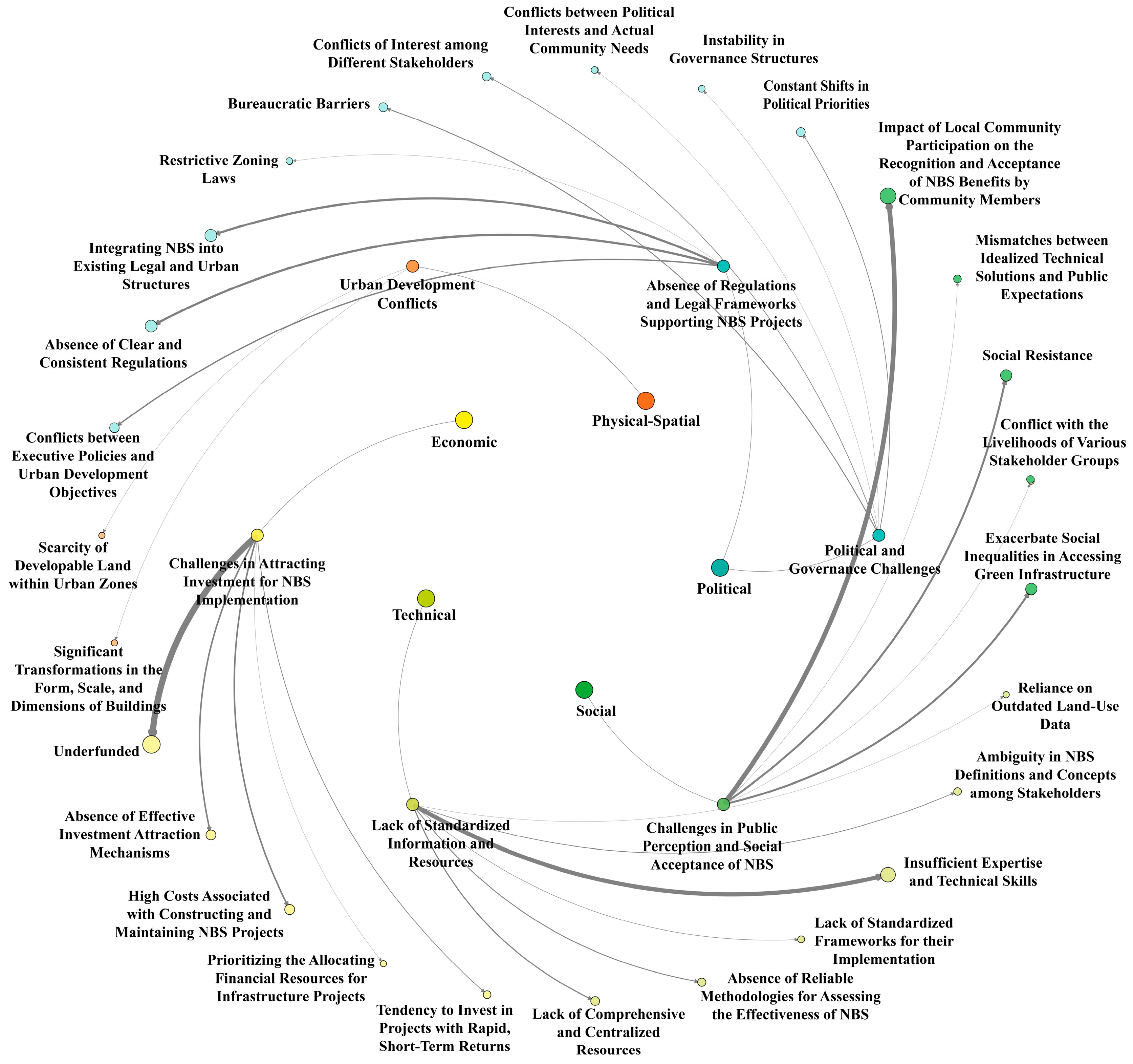
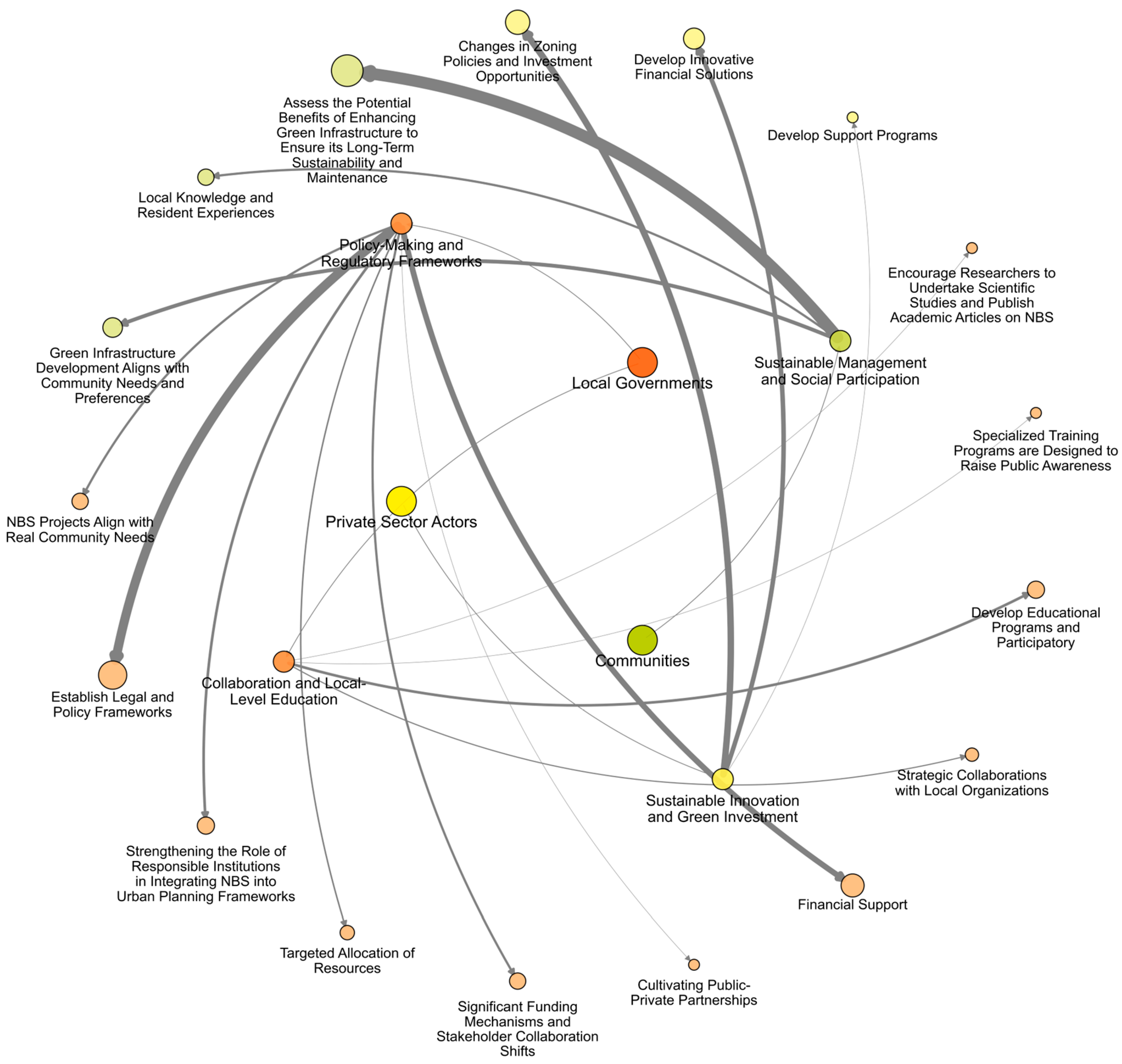
| Country | No. of Publications | No. of Citations | Average No. of Citation per Paper | Total Link Strength | |
|---|---|---|---|---|---|
| 1 | United Kingdom | 12 | 1013 | 84.4 | 68 |
| 2 | The Netherlands | 12 | 994 | 82.8 | 64 |
| 3 | Germany | 11 | 957 | 87 | 57 |
| 4 | Italy | 13 | 916 | 70.4 | 73 |
| 5 | Sweden | 8 | 855 | 106.8 | 53 |
| 6 | Romania | 3 | 726 | 242 | 40 |
| 7 | Belgium | 3 | 508 | 169.3 | 24 |
| 8 | United States | 15 | 450 | 30 | 16 |
| 9 | Denmark | 6 | 269 | 44.8 | 19 |
| 10 | Australia | 11 | 230 | 20.9 | 42 |
| Methodology | Analysis Method | References | |
|---|---|---|---|
| Quantitative | Multi-Criteria Decision Analysis | Spatial Multi-Criteria Analysis | [40,41] |
| Hydrological Modeling | I-Tree Hydro Plus Model | [42] | |
| HEC-HMS Model | [43] | ||
| HEC-RAS Model | [43] | ||
| Descriptive Statistics | Tables and Charts | [23,44,45] | |
| Analysis of Variance | [45,46] | ||
| Analysis of Covariance | [46] | ||
| Mann–Whitney U Test | [46] | ||
| Pearson Correlation Coefficient | [47] | ||
| Multiple Linear Regressions | [48] | ||
| Forecast Model | Adoption and Diffusion Outcome Prediction Tool | [49] | |
| Ordinary Least Squares Regression | [47] | ||
| Documentary Method | Heat Flow Meter (HFM) Method | [50] | |
| Economic Analysis Methods | Cost-Effectiveness Analysis | [51] | |
| Assessment Method | Adoption and Diffusion Outcome Prediction Tool | [49] | |
| SCS-CN Method | [47,52] | ||
| Pollution Flux Method | [47] | ||
| Qualitative | Situational Analysis | Case Study Method | [53,54,55,56] |
| Geographic Comparative Analysis | [57,58,59,60,61] | ||
| Critical Analysis | Literature Review | [16,26,27,28,29,30,55,62,63,64,65] | |
| Critically Analyzing | [66] | ||
| Conversation Analysis | Semi-Structured Interviews | [3,67,68,69,70,71,72,73] | |
| Depth Interviews | [74] | ||
| Structured Face to Face Interviews | [19,75] | ||
| Interviews | [25,29,55,63] | ||
| Survey | [25,63] | ||
| Content Analysis | Transcribed and Coded | [24,29,70,75,76,77,78,79,80,81,82,83,84,85] | |
| Observational Analysis | Mapping Analysis | [86,87,88,89,90] | |
| Mixed Method | Mixed Technique | Mixed Quantitative and Qualitative Methods | [1,2,10,18,21,91,92,93,94,95,96,97,98,99,100,101,102,103,104,105,106,107,108,109,110,111,112,113] |
Disclaimer/Publisher’s Note: The statements, opinions and data contained in all publications are solely those of the individual author(s) and contributor(s) and not of MDPI and/or the editor(s). MDPI and/or the editor(s) disclaim responsibility for any injury to people or property resulting from any ideas, methods, instructions or products referred to in the content. |
© 2025 by the authors. Licensee MDPI, Basel, Switzerland. This article is an open access article distributed under the terms and conditions of the Creative Commons Attribution (CC BY) license (https://creativecommons.org/licenses/by/4.0/).
Share and Cite
Zarei, M.; Shahab, S. Nature-Based Solutions in Urban Green Infrastructure: A Systematic Review of Success Factors and Implementation Challenges. Land 2025, 14, 818. https://doi.org/10.3390/land14040818
Zarei M, Shahab S. Nature-Based Solutions in Urban Green Infrastructure: A Systematic Review of Success Factors and Implementation Challenges. Land. 2025; 14(4):818. https://doi.org/10.3390/land14040818
Chicago/Turabian StyleZarei, Melika, and Sina Shahab. 2025. "Nature-Based Solutions in Urban Green Infrastructure: A Systematic Review of Success Factors and Implementation Challenges" Land 14, no. 4: 818. https://doi.org/10.3390/land14040818
APA StyleZarei, M., & Shahab, S. (2025). Nature-Based Solutions in Urban Green Infrastructure: A Systematic Review of Success Factors and Implementation Challenges. Land, 14(4), 818. https://doi.org/10.3390/land14040818







